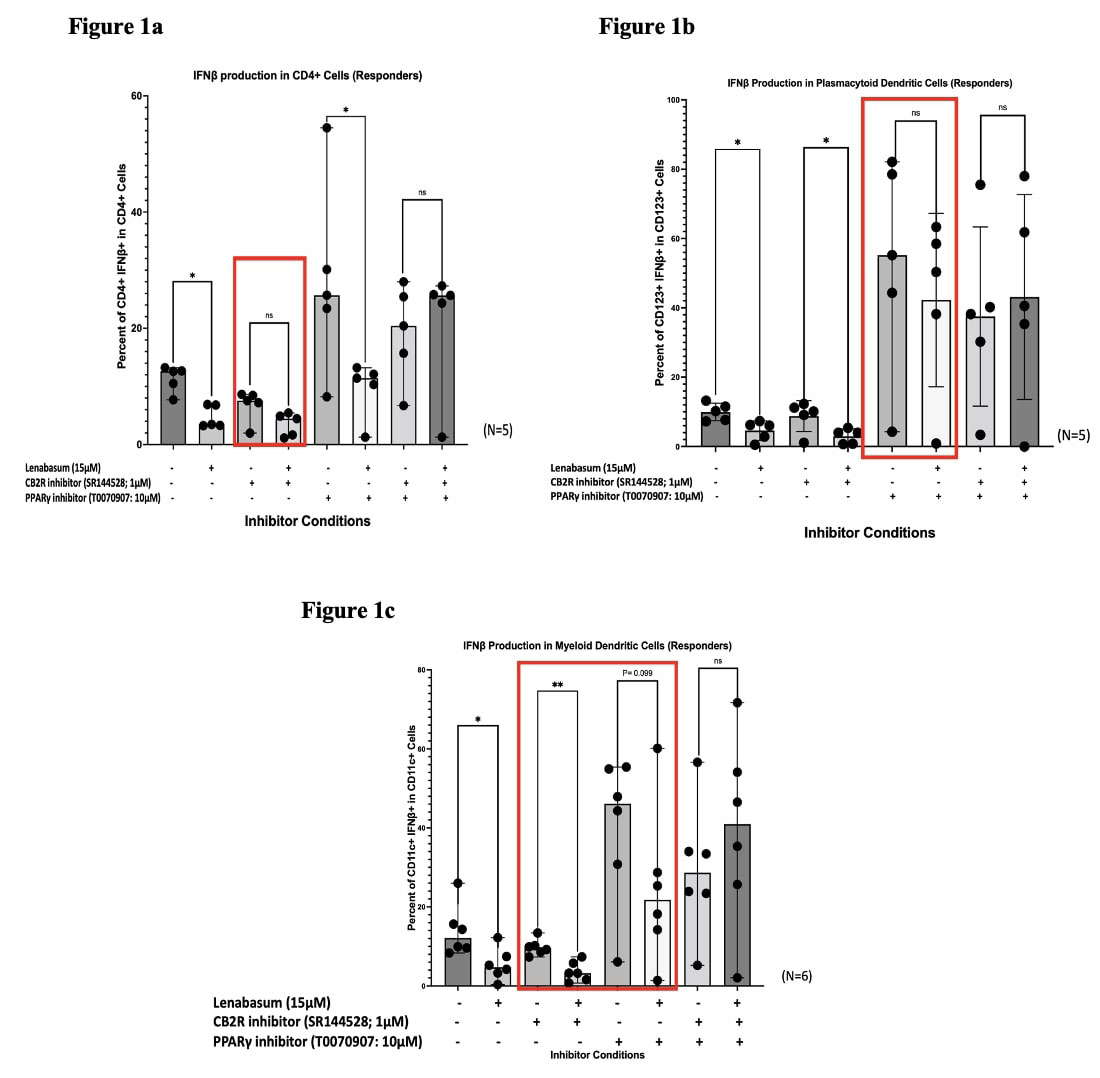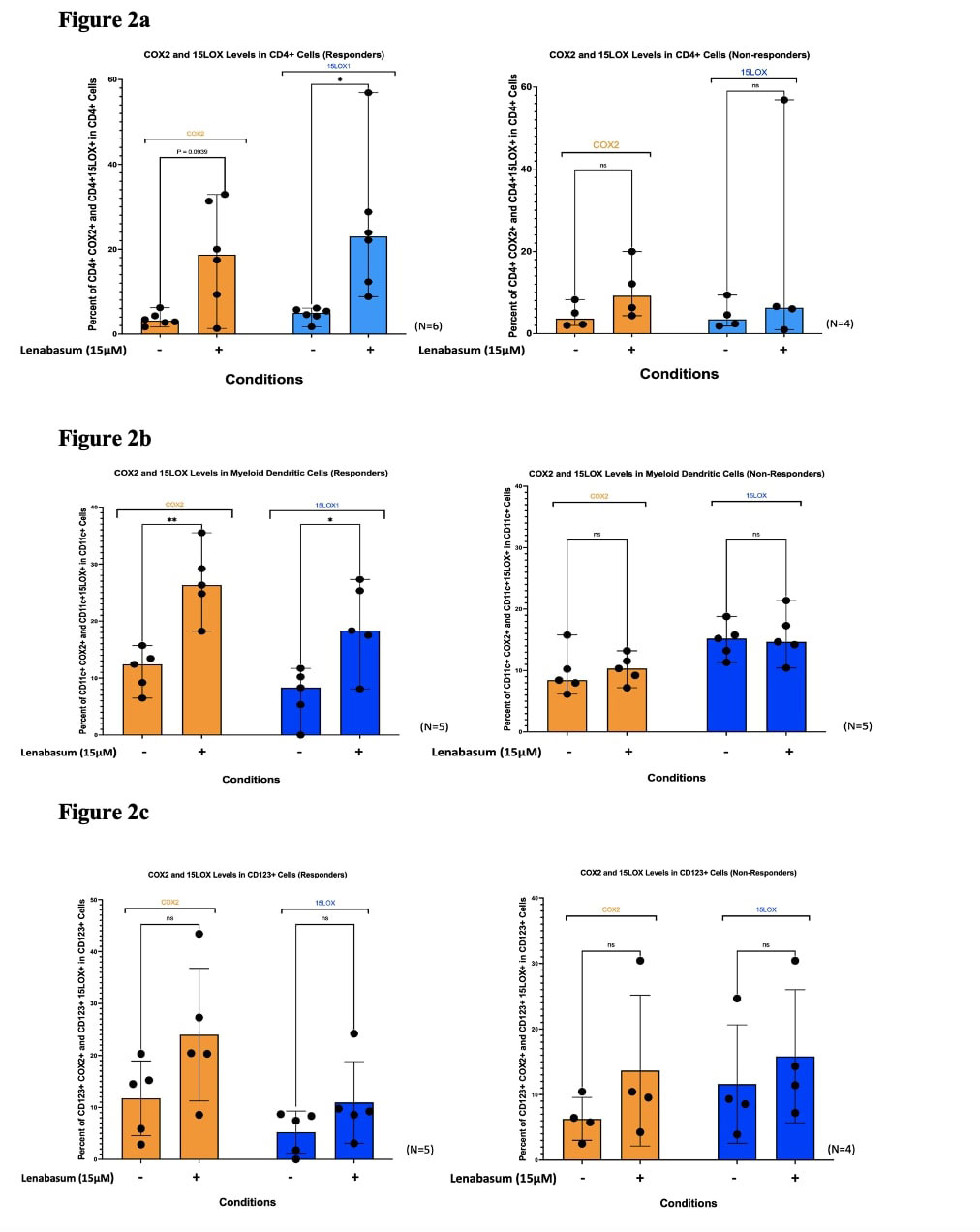Session Information
Session Type: Poster Session D
Session Time: 1:00PM-3:00PM
Background/Purpose: Dermatomyositis (DM) is a systemic autoimmune disease that affects the skin and muscle. Lenabasum, a cannabinoid type 2 receptor (CB2R) agonist, has been developed as a potential treatment to reduce inflammation in DM. Additional research has also shown that lenabasum also exerts its anti-inflammatory effects through the binding of peroxisome proliferator-activated receptor gamma (PPARγ).
Methods: We investigated the downstream lenabasum-specfic pathway preference through CB2R or PPARγ in various leukocyte cell lines. We used IFNβ, a major driver of DM, as a marker for inflammation and various combinations of CB2R and PPARγ inhibitors on DM whole blood leukocytes. Prior research has shown that activation of CB2R allows for the recruitment of cyclooxygenase 2 (COX2) and lipoxygenase enzymes (15LOX). These enzymes were utilized as biomarkers for CB2R pathway activation. Flow cytometry was used to quantify differences in IFNβ levels with various CB2R/PPARγ inhibitions in the presence of lenabasum (15μmol).
Results: We found that lenabasum acts through the CB2R in CD4T+ cells due to a significant reduction (Median Frequency of Parent [MFOP] from 12.6% to 3.46%; p< 0.05) in IFNβ upon treatment with lenabasum but a slight nonsignificant decrease (MFOP from 7.56% to 4.46%; p >0.05) when CB2 receptors were inhibited (Figure 1a). Downstream lenabasum-specific CB2R pathway activation was confirmed in these cells with a significant increase in COX2 (MFOP from 3.16% to 18.715%; p< 0.05) and 15LOX (MFOP from 5.01% to 12.32%; p< 0.05) upon treatment with lenabasum in DM responders versus a non-significant increase in these enzymes (MFOP from 3.63% to 9.215%; p >0.05) in DM non-responders (Figure 2a). Plasmacytoid dendritic cells (pDCs) favor a PPARγ-dominant pathway due to the significant reduction in IFNβ levels (MFOP from 9.964% to 2.86%) when treating with lenabasum with or without CB2R inhibition, but a non-significant decrease (MFOP from 55.21% to 42.246%) when inhibiting PPARγ (Figure 1b). Both COX2 and 15LOX levels had no significant increase when treating with lenabasum in DM responders, suggesting a non-CB2R pathway in pDCs (Figure 2c). The myeloid dendritic cells (mDCs) demonstrated an ability to activate both CB2R and PPARγ pathways. In these cell lines, lenabasum significantly reduced IFNβ levels when either CB2R (MFOP from 9.545% to 3.2215%) or PPARγ (MFOP from 46.105% to 21.775%) were inhibited independently. However, when both receptors were inhibited simultaneously, treatment with lenabasum showed a nonsignificant increase (MFOP from 28.665% to 40.91%) in IFNβ levels (Figure 1c). COX2 and 15LOX levels were also significantly increased in mDCs when treated with lenabasum in the DM responders versus the DM non-responders, suggesting a CB2R pathway activation (Figure 2b).
Conclusion: Altogether, these results show that lenabasum has a cell-specific pathway preference in the blood and the efficacy of the treatment could vary across patients due to potential baseline cell-to-cell differences in CB2R and PPARγ levels.
To cite this abstract in AMA style:
Kodali N, Vazquez T, Diaz D, Dan J, Sprow G, Dhiman R, Ogawa-Momohara M, Bashir M, Sharma M, Werth V. Lenabasum, a Cannabinoid Type 2 Receptor Agonist, Activates Diverse Cell-specific Pathways in Whole Blood Leukocytes in Dermatomyositis [abstract]. Arthritis Rheumatol. 2022; 74 (suppl 9). https://acrabstracts.org/abstract/lenabasum-a-cannabinoid-type-2-receptor-agonist-activates-diverse-cell-specific-pathways-in-whole-blood-leukocytes-in-dermatomyositis/. Accessed .« Back to ACR Convergence 2022
ACR Meeting Abstracts - https://acrabstracts.org/abstract/lenabasum-a-cannabinoid-type-2-receptor-agonist-activates-diverse-cell-specific-pathways-in-whole-blood-leukocytes-in-dermatomyositis/


